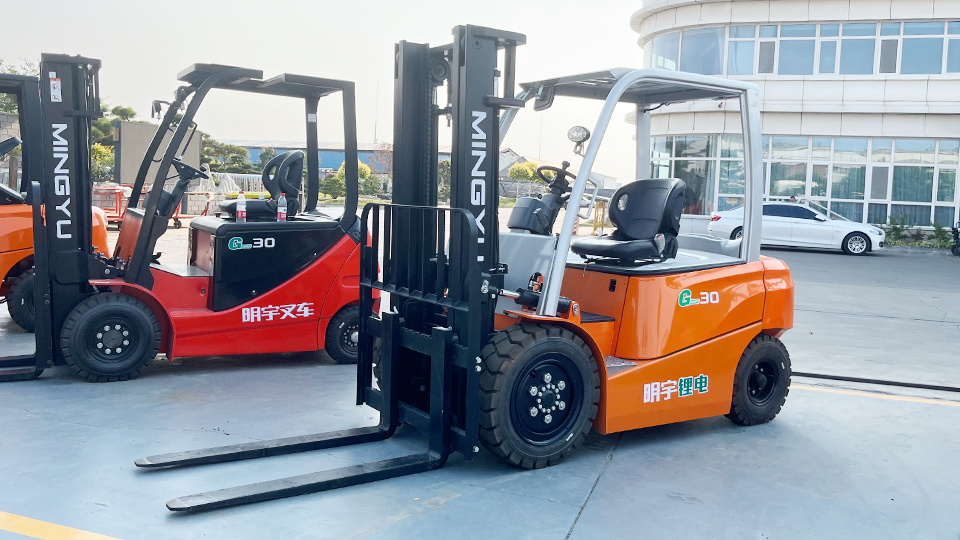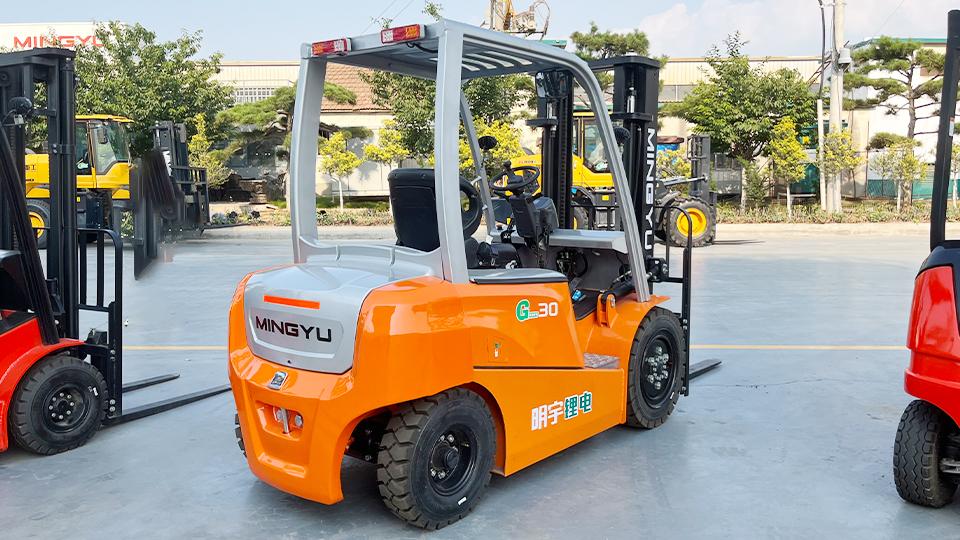
The debate between Toyota and Caterpillar forklifts is a long-standing one, often resembling the classic Ford vs. Chevy rivalry in the automotive industry. Both brands command significant market share and are synonymous with quality, but they cater to slightly different market segments and philosophies. There isn't a single "better" brand, as the optimal choice depends heavily on the specific application, budget, operational priorities, and long-term strategic goals of a business.
This article will dissect the key areas of comparison: Brand Philosophy and Market Positioning, Reliability and Durability, Performance and Technology, Ergonomics and Safety, Operating Costs and Total Cost of Ownership (TCO), Dealer Network and Aftermarket Support, and Environmental Initiatives.
1. Brand Philosophy and Market Positioning
Toyota Material Handling: Toyota is globally recognized for its Toyota Production System (TPS), a lean manufacturing philosophy that emphasizes efficiency, waste reduction, and continuous improvement (Kaizen). This philosophy is deeply ingrained in their forklift design and manufacturing processes. Toyota forklifts are often perceived as highly reliable, fuel-efficient, and easy to maintain, appealing to a broad range of industries, particularly those focused on lean operations, warehousing, and general manufacturing. They frequently hold the top spot in global market share and are known for their consistent quality across a wide product range.
Caterpillar Lift Trucks (Mitsubishi Logisnext Americas): While globally recognized for heavy construction equipment, Caterpillar's forklift division (Cat Lift Trucks) is a significant player, particularly in the industrial and heavy-duty segments. Their forklifts are often associated with ruggedness, power, and robust performance, echoing the brand's reputation for tough machinery. Cat Lift Trucks, now part of Mitsubishi Logisnext Americas, focuses on delivering durable and dependable material handling solutions, often excelling in demanding outdoor applications and environments where brute force and endurance are paramount.

2. Reliability and Durability
Both Toyota and Caterpillar have strong reputations for building durable equipment, but their approaches and perceived strengths differ.
Toyota:
Reliability: Toyota forklifts are consistently lauded for their exceptional reliability and minimal downtime. This is a direct result of their rigorous quality control, standardized manufacturing processes, and the widespread availability of parts. Their "System of Active Stability (SAS)" is a prime example of their focus on proactive safety, which indirectly contributes to reliability by preventing tip-overs and reducing stress on components.
Durability: While durable, Toyota's standard models might be perceived as less "heavy-duty" than some Caterpillar counterparts in extreme applications. However, their build quality ensures a long operational life with proper maintenance. For typical warehouse and manufacturing environments, their durability is more than sufficient. Toyota's consistent top ranking in industry surveys for reliability underscores their performance in this area.
Caterpillar:
Reliability: Caterpillar forklifts are also known for their robust construction and reliable performance, particularly in demanding conditions. Their industrial-grade components are built to withstand harsh environments and heavy usage.
Durability: Caterpillar often emphasizes the ruggedness and sheer power of its machines. Their heavy-duty models, especially internal combustion (IC) pneumatic tire forklifts, are designed for challenging outdoor applications like lumber yards, construction sites, and container handling, where durability under stress is paramount. Customer reviews often highlight their ability to "take a beating" and continue operating.
3. Performance and Technology
Both brands offer a wide range of forklifts (electric, LPG, diesel, gasoline) with varying capacities, but their technological focuses sometimes diverge.
Toyota:
Electric Forklifts: Toyota is a leader in electric forklift technology, offering a comprehensive range of 3-wheel and 4-wheel electric models (e.g., Traigo48 series). They are heavily investing in lithium-ion battery technology, offering faster charging, longer runtimes, and reduced maintenance. Features like regenerative braking are standard, maximizing energy efficiency. Toyota's electric models often emphasize maneuverability and precision, making them ideal for indoor warehousing and tight spaces.
IC Forklifts: Toyota's IC forklifts are known for their fuel efficiency and advanced emission control systems, often surpassing federal and state environmental standards. They prioritize operator comfort and ease of use.
Innovation: Toyota is at the forefront of material handling innovation, exploring automation, robotics, and advanced telematics (MyToyota fleet management platform). Their focus is on integrated solutions for overall warehouse efficiency.
Caterpillar:
Electric Forklifts: Caterpillar has also expanded its electric forklift offerings, including heavy-duty electric counterbalance models with capacities up to 12 tonnes. They recognize the growing trend towards electrification and are integrating lithium-ion technology into their new EQ line of warehouse trucks. Their electric models are designed for robust performance and extended run times.
IC Forklifts: Caterpillar excels in powerful IC forklifts, particularly diesel and LPG models, designed for heavy lifting and demanding outdoor conditions. Their engines are known for high torque and endurance. They offer features like fuel-save modes and engine protection systems.

Innovation: Caterpillar's innovation often focuses on enhancing the power, durability, and operational economy of its machines. They emphasize features that improve productivity in challenging environments and offer telematics solutions for fleet management and diagnostics.
4. Ergonomics and Safety
Both manufacturers place a high priority on operator safety and comfort, which are crucial for productivity and reducing accidents.
Toyota:
Safety: Toyota is renowned for its System of Active Stability (SAS), a patented technology that electronically monitors forklift operations and automatically engages systems to reduce the risk of tip-overs. This includes features like Active Mast Control (AMC), which limits forward tilt based on load and height, and active steer control. They also prioritize visibility with features like clear overhead guards and low dashboards.
Ergonomics: Toyota forklifts are designed with operator comfort in mind, featuring adjustable full-suspension seats, easy-grip controls, spacious operator compartments, and reduced noise and vibration levels. Skid-resistant steps and assist grips enhance entry and exit safety.
Caterpillar:
Safety: Caterpillar forklifts also incorporate numerous safety features, including operator presence detection systems, highly visible seatbelts, and engine protection systems that can slow the truck down if critical components are at risk. They offer extensive operator training programs through their dealer network.
Ergonomics: Caterpillar designs aim for operator comfort with features like full-suspension seats, narrow steering columns, and tilt-adjustable steering. They emphasize reduced noise and vibration, which contribute to operator well-being and reduced fatigue, especially in long shifts.
5. Operating Costs and Total Cost of Ownership (TCO)
The total cost of ownership is a critical metric, encompassing not just the purchase price but also fuel/energy, maintenance, repairs, depreciation, and downtime.
Toyota:
Initial Cost: Toyota forklifts are generally considered to have a higher initial purchase price than some competitors, reflecting their reputation for quality and advanced features.
Operating Costs: They often boast lower operating costs due to their fuel efficiency (especially electric models), lower maintenance requirements, and exceptional reliability leading to less downtime. Their parts are widely available, and their robust build contributes to a longer useful life.
Resale Value: Toyota forklifts typically command excellent resale values, making them a strong asset investment over time. This high residual value significantly contributes to a lower TCO.
MyToyota Telematics: Toyota's MyToyota fleet management platform provides detailed insights into fleet utilization, cost tracking, and predictive maintenance, enabling businesses to actively reduce their TCO.
Caterpillar:
Initial Cost: Caterpillar forklifts can also have a premium initial price, especially for their heavy-duty or specialized models, aligning with their focus on robust construction and power.
Operating Costs: While specific fuel efficiency can vary by model and application, Caterpillar's emphasis on engine efficiency (e.g., fuel-save modes in IC models) and advanced AC technology in electric models helps manage operational costs. Maintenance costs are often competitive, supported by durable components.
Resale Value: Caterpillar forklifts generally hold good resale value, particularly their more robust IC models, due to their reputation for durability and longevity.
Total Cost Considerations: Caterpillar provides tools and resources for calculating life cycle costs, encouraging buyers to look beyond the initial purchase price to include maintenance, repairs, and fuel/energy expenses.
6. Dealer Network and Aftermarket Support
Both companies leverage extensive dealer networks for sales, service, parts, and training.
Toyota:
Network: Toyota Material Handling boasts one of the largest and most established dealer networks globally. This widespread presence ensures excellent accessibility for sales, service, and parts.
Support: Their dealers are known for strong technical support, well-stocked parts departments, and highly trained technicians. Toyota emphasizes comprehensive service programs and operator training. The availability of genuine Toyota parts is generally high, contributing to faster repairs and less downtime.
Caterpillar:
Network: Caterpillar Lift Trucks also operates through a vast global dealer network, often shared with other Caterpillar construction and industrial equipment. This can be an advantage for businesses that already have a relationship with a Cat dealer for other machinery.
Support: Cat dealers are known for their robust service capabilities, offering comprehensive maintenance programs, parts availability, and technical expertise. They often provide strong support for heavy-duty applications.
7. Environmental Initiatives
Both brands are increasingly focusing on sustainability and reducing their environmental footprint.
Toyota:
Electrification: Toyota is a strong advocate for electric forklifts, which produce zero direct emissions, making them ideal for indoor and environmentally sensitive applications. Their push for lithium-ion technology further enhances energy efficiency and reduces the need for traditional battery maintenance.
Manufacturing: Toyota's manufacturing processes incorporate numerous energy-saving measures, aiming to reduce CO2 emissions and increase the use of recyclable parts. They were pioneers in offering UL-listed, EPA, and CARB-certified Compressed Natural Gas (CNG) powered forklifts.
Caterpillar:
Electrification: Cat Lift Trucks is also expanding its electric range, including larger capacity electric counterbalance forklifts, recognizing the shift towards electrification to reduce emissions. Their new EQ line heavily features lithium-ion battery technology.
Sustainability Goals: Cat Lift Trucks and its partners have ambitious goals for carbon emission reduction (40% by 2030, net zero by 2040) across their operations and supply chain. They promote circular economy principles, focusing on durability, easy servicing, and remanufactured parts to extend product life and reduce waste. They are also transitioning to more environmentally friendly painting processes.
Conclusion: The "Better" Forklift is Application-Specific
The question of "Toyota vs. Caterpillar: which is better?" does not have a universal answer. Both are top-tier manufacturers producing high-quality, reliable, and technologically advanced forklifts. The "better" choice is inherently subjective and depends on a company's unique operational profile, budget, and priorities.
Choose Toyota if:
Reliability and consistent uptime are paramount.
You prioritize lean operations and fuel efficiency, especially in electric models.
Your primary application is indoor warehousing, general manufacturing, or environments requiring precision and maneuverability.
You value advanced safety features and operator ergonomics.
You seek a strong resale value and a lower overall TCO over the long term.
You desire cutting-edge telematics and fleet management solutions.
Choose Caterpillar if:
You require ruggedness, brute power, and extreme durability for demanding outdoor applications.
Your operations involve heavy lifting, rough terrain, or harsh environmental conditions.
You already have an existing relationship with a Cat dealer for other equipment.
You appreciate robust engineering and the ability of machines to "take a beating."
You need high-capacity IC forklifts for specialized industrial tasks.
Ultimately, potential buyers should conduct a thorough needs assessment, considering factors such as:
Load capacity and lift height requirements
Operating environment (indoor/outdoor, temperature, floor conditions)
Duty cycle and operating hours
Budget (initial purchase vs. total cost of ownership)
Fuel type preference and energy costs
Specific safety and ergonomic needs
Availability and quality of local dealer support
By carefully evaluating these factors against the distinct strengths of Toyota and Caterpillar, businesses can make an informed decision that leads to the most efficient, cost-effective, and productive material handling solution for their specific challenges. Both brands represent excellent investments, but the truly "better" forklift is the one that perfectly aligns with your operational demands and long-term business goals.
Name: selena
Mobile:+86-13176910558
Tel:+86-0535-2090977
Whatsapp:8613181602336
Email:vip@mingyuforklift.com
Add:Xiaqiu Town, Laizhou, Yantai City, Shandong Province, China